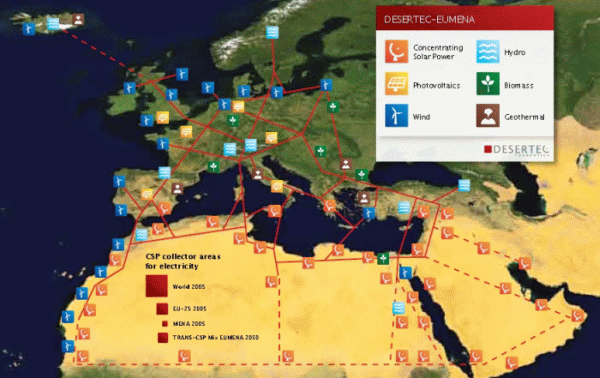

Desertec: an energy, CO2, water and food solution
The Problem: 10 billion people on Earth by 2050, and a demand for resources equivalent to three Earths.
The Solution: The DESERTEC Concept. "It simultaneously tackles efficiently all the global challenges of the upcoming decades: shortage of energy, water and food as well as excessive emissions of CO2. At the same time, this concept offers new options for the prosperity and development of regions that have so far, from an economic point of view, been scarcely developed.
"CLEAN ENERGY IS AVAILABLE IN ABUNDANCE THE EARTH‘S DESERT BELT
"North and south of the equator, deserts span the Earth. Over 90% of the world‘s population could be supplied with clean power from deserts by using technologies that are available today."
Download the Desertec Red Paper
Whew. That's no small thinking. But the world has enjoyed, or has had to suffer, many technological "visionaries" with big ideas that will solve everything, yadda, yadda, yadda.
So is Desertec any different? Is it credible? Can it be done? Should it be attempted?
What is Desertec?
The specific plan is to generate electricity in desert regions of the Middle East and North Africa (MENA) using Concentrating Solar Thermal (CSP) plants. Then wheel that power primarily to Europe, using High Voltage Direct Current (HVDC) transmission cables buried underground and submerged beneath the Mediterranean Sea.
CSP entails a number of large solar reflectors aimed at a single tube in which is a working fluid, which, when heated, is used as an energy source for a power generation station. Wikipedia has an introduction to CSP:
http://en.wikipedia.org/wiki/Concentrating_solar_power.
HVDC is an established transmission technology which has three advantages over AC transmission: no electromagnetic effects ("electro smog"), fewer transmission losses, and reduced cost over long distances. Wikipedia again:
http://en.wikipedia.org/wiki/High-voltage_direct_current
 Click here for larger map |
Desertec arose out of a feasibility study commissioned by the German Ministry of the Environment, and it is still very much a German project with Deutsche-Bank, RWE, E-ON, Munich-RE, Siemens all apparently on-board. The €400 billion project may provide 20 percent of European energy needs by 2050.
You can read more about it at http://www.desertec.org.
At the top we quoted the Desertec red paper saying the project will tackle shortage of energy, water, food, and CO2 emissions. The energy and CO2 factors are obvious. Desalination plants would also use the energy. Food? The red paper doesn't explain that - maybe by irrigation using the desalinated water? Posted by Arthur Caldicott on 27 Jul 2009